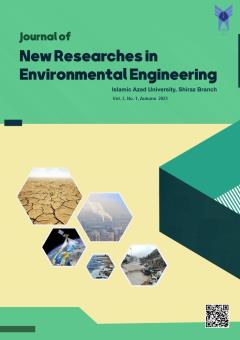Evaluation of Knowledge and Attitude of Non-medical Students about Virtual Water Recognize with the Approach of Environmental Protection and Sustainable Development
Subject Areas : Environmental crises
1 - Department of Envionmental science, Arsanjan Branch, Islamic Azad University, Arsanjan, Iran
Keywords: Knowledge, Virtual Water, Protection, Environment, Training.,
Abstract :
Introduction: Despite the climatic changes and the recent droughts in Iran, as well as, the rising trend of development of industrial and agricultural activities, Iran are exposed to the severe water crisis. Thus, in order to tackle this problem, and management of water supplies at risk, virtual water and water footprint Culture Assessment an acceptable method for achieving sustainable development and environmental protection goals. To reduce and prevent water crisis as well as protection of environment the current study was, therefore, undertaken to determine the level of knowledge and attitudes of non-medical students on virtual water principles in environmental protection goals. Materials and Methods: This study was a descriptive analytical study and samples include 384 non-medical students from Islamic Azad universities in Fars province who were selected by convenient sampling method. The self-administrated questionnaire included a demographic questionnaire and as well as their knowledge on virtual water and practice regarding willingness to conservation of environment was completed for all the study population through interviews. Subsequently, descriptive statistics, x2, and Mann-Whitney test and kruscal-wallis test were employed for analysis using SPSS Software (version 21). Results and Discussion: The findings of this study showed that, 98.2 percent of the people had poor awareness about virtual water recognize and role of virtual water in environmental protection and 83.8% of people were interested in increasing knowledge and attitudes on virtual water. On the other hand, there was a significant correlation between knowledge and sex, awareness and levels of education and knowledge and age (P< 0.05). Conclusion: The findings of this study showed that, 98.2 percent of the people had poor awareness about virtual water recognize and role of virtual water in environmental protection and 83.8% of people were interested in increasing knowledge and attitudes on virtual water. On the other hand, there was a significant correlation between knowledge and sex, awareness and levels of education and knowledge and age (P< 0.05).
Abedi S, Tahami pour M. Measurement and Analysis of Virtual Water Trade Balance in Agriculture Sector of Zanjan Province. Iranian journal of agricutural economics and development research, 2017;47(4 ):805-814. [In Persian] https://doi.org/10.22059/ijaedr.2016.61310
Aldaya MM, Chapagain AK, Hoekstra AY, Mekonnen MM. The water footprint assessment manual: Setting the global standard. Routledge; 2012 Aug 21
. Allan JA. Virtual water: a strategic resource. Global solutions to regional deficits. Groundwater. 1998; 36(4): 545-546
. Allan JA. Water security in the Middle East: The hydro-politics of global solutions. New York, NY: Columbia University Press; 2002
. Arabi-Yazdi A, Alizadeh A, Mohamadian F. Study on ecological water footprint in agricultural section of Iran. Water and Soil. 2009 Oct 23;23(4). [In Persian] https://doi.org/10.22067/jsw.v0i0.2463
Baghestany, A. A., Mehrabi Boshrabadi, H., Zare Mehrjerdi, M., Sherafatmand, H. Application of the Concept of Virtual Water in Water Resources Management of Iran. Iran-Water Resources Research, 2010; 6(1): 28-38. [In Persian]
Bazrafshan O.B, Gerkani Nezhad Moshizi Z. Assessment of Water Use Efficiency and Water Footprint of Saffron Production in Iran. Saffron agronomy and technology. 2020;7(4):505-519. [In Persian] https://doi.org/10.22048/jsat.2019.141824.1311
Duarte R, Sánchez-Chóliz J, Bielsa J. Water use in the Spanish economy: an input–output approach. Ecological Economics. 2002 Nov 1;43(1):71-85. https://doi.org/10.1016/S0921-8009(02)00183-0
Hatirli SA, Ozkan B, Fert C. Energy inputs and crop yield relationship in greenhouse tomato production. Renewable Energy. 2006 Apr 1;31(4):427-38. https://doi.org/10.1016/j.renene.2005.04.007
. Hoekstra AY, Chapagain AK. Water footprints of nations: water use by people as a function of their consumption pattern. Integrated assessment of water resources and global change: A north-south analysis. 2007:35-48. https://doi.org/10.1007/978-1-4020-5591-1_3
Hoekstra AY, Chapagain AK, Aldaya MM, Mekonnen MM. Water footprint manual: State of the art 2009. Water footprint network, enschede, the Netherlands. 2009 Nov;255
. Hoekstra AY, Chapagain AK. Globalization of water: Sharing the planet's freshwater resources. John Wiley & Sons; 2011 Aug 31
. Hummel D, Kluge T, Liehr S, Hachelaf M, Allee H. Virtual water trade. Institute for Social-Ecological Research (ISOE) in Frankfurt/Main. 2006 Jul 3
. Jabbour, C. J. C., de Sousa Jabbour, A. B. L., Govindan, K., Teixeira, A. A., and de Souza Freitas, W. R. “Environmental management and operational performance in automotive companies in Brazil: the role of human resource management and lean manufacturing”. Journal of Cleaner Production, (2013). 47, 129-140. https://doi.org/10.1016/j.jclepro.2012.07.010
Khalili, T., Sarai Tabrizi, M., Babazadeh, H., Ramezani Etedali, H. Evaluation of Virtual Water Footprint in Crop, Livestock and Agricultural Consumption Inputs (Case Study: Gom, Province). Water and Soil, 2021; 35(2): 167-178. doi: 10.22067/jsw.2021.14826.0
Liu H, Sun S, Fang C, van den Berg P, Dane G, Li J, Fu G. Public perceptions of physical and virtual water in China. Science of the Total Environment. 2022 Mar 15;812:151460. https://doi.org/10.1016/j.scitotenv.2021.151460
Mekonnen M, Hoekstra AY. National water footprint accounts: The green, blue and grey water footprint of production and consumption. Volume 1: Main Report.2011
. Miryaghoubzadeh, M., Khosravi, S., Ebrahim, S., Zabihi, M. Virtual Water, New Approach to Water Crisis. Extension and Development of Watershed Management, 2019; 7(24): 11-20. [In Persian]
Oveisi F., Fattahi Ardakani A., fehresti sani M.. Investigation of Virtual Water and Ecological Footprints of Water in Wheat Fields of Isfahan Province. Water and Soil Science (journal of science and technology of agriculture and natural resources). 2019;23(1 ):87-99. [In Persian] https://doi.org/ 10.29252/jstnar.23.1.7
Postel SL, Daily GC, Ehrlich PR. Human appropriation of renewable fresh water. Science. 1996 Feb 9;271(5250):785-8. DOI: 10.1126/science.271.5250.785
Ramezani Etedali, H., Shokoohi, A., Mojtabavi, S. A. Using the Concept of Virtual Water Footprint in Main Crops Production for Crossing the water crisis in Qazvin. Water and Soil, 2017; 31(2): 422-433. doi: 10.22067/jsw.v31i2.55628
Zehnder AJ, Yang H, Schertenleib R. Water issues: the need for action at different levels. Aquatic sciences. 2003 Mar;65:1-20. https://doi.org/10.1007/s000270300000

